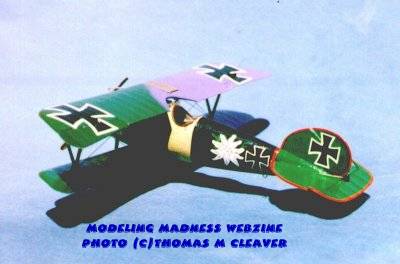
Eduard 1/48 Albatros D.V
Review and Photo by Tom Cleaver

I've been building so many out-of-the-box review models recently, that I needed a break and to just kick back and do one my way for the joy of doing it In my other existence, I am a writer, so an airplane whose pilot has such a writerly connection with history was a challenge impossible to turn down.
Paul Baumer, born in 1897, already had his pilot's license by the time he joined the German Army in 1915, but he still spent 18 months in the trenches of the Western Front before being transferred to the Fliegertruppe in 1917. Known as "The Iron Eagle," he flew with the "Greentails" of Jasta 5 in the rapidly-obsolescing Albatros D.V, and achieved a final score of 44, making him the ninth-ranked German ace of the First World War. After the war, he became a dentist but still kept flying, and was known throughout Europe in the early and mid-Twenties for his beautiful aerobatic air displays. Known as "incredibly decent" by all who met him, Baumer had friends in all parts of society throughout Germany. When he was killed in an accident during an air display in Copenhagen on May 31, 1927, mere weeks after his 30th birthday, his loss affected all who knew him. The one most affected by his death was a fellow war veteran and writer, who was at that time in the process of finishing his war novel; he renamed the main character after his friend - who he had used as the model for the character - and conferred immortality on him with that act, because the writer's name was Erich Maria Remarque, and the novel was "All Quiet On The Western Front."
The Model:
The model is Eduard's beautiful Albatros D.V, which is reviewed in detail so far as construction notes are concerned in my other article here. For this model, I cut the control surfaces and posed them, being certain to pose the rudder bar and stick in the well-detailed cockpit accordingly. As I said before, building this kit straight from the box will give you a great model.
The Markings:
I used SuperScale's Albatros D.V sheet, 48-151, as the basis of this, since it provides the outline of the "Edelweiss" that was Baumer's personal insignia. Past that, the sheet is virtually useless, since most of the information is incorrect.
The sheet would have you paint the rear of the fuselage between tail and cockpit red. Of course, it would have to be, wouldn't it? After all, it's a World War I German fighter, isn't it? They all had red, didn't they?
Wrong.
Baumer's airplane was painted black over that part of the fuselage, just as Von Hippel's lightning bolt was black, not red. (Fortunately, Eduard has done Von Hippel's "Blitz" in their special aces series, and done it right.) I'm lucky to have one of the best World War I modelling resources available in my own backyard, so to speak, in that Robert Karr - probably the best World War I modeler in America - is a near neighbor (Actually, only a 45 minute drive away, out of rush hour; in Los Angeles that's practically next door.) Robert did this airplane as one of his early scratchbuilt models, so it was a case of monkey-see, monkey-do. Once the fuselage was painted and the MicroScale "light wood" decal applied in panel sections to imitate the plywood construction of the actual airplane, I put on the Edelweiss, and then painted the detail - the green leaves, the seeds, the black petal outlines; believe me, you may not see them in detail on a 75dpi screen, but they're there.
There was a recent thread at rec.models.scale asking "what model would you build if you could only do one from now on?" One post replied "The Albatros, since there are so many individual markings." He was right. This is an excellent kit of a beautiful airplane, and there are lots of possibilities to do with it.
Just be sure to check your facts. If a decal maker says it, that doesn't necessarily make it so.